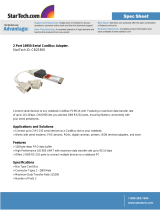Page is loading ...

Mar/07 MN7000000035
1
2S1P CardBus Adapter
User Manual
Ver. 2.00
All brand names and trademarks are properties of their
Respective owners.

Mar/07 MN7000000035
2
Features and Benefits
Features z Compatible with 32-bit CardBus slot
z Easy to Plug-n-Play installation
z Simple and easy way to connect devices to your
notebooks
z Serial data transfer rate up to 115200bps
z Parallel data transfer rate up to 1.5MB/Sec
Bus z CardBus Type II, 32-bit, 33MHz, 3.3V
Connectors z 1 x DBHD44 Female on CardBus Adapter
z 2 x DB9 Male Serial Connectors on Fan Out Cable
z 1 x DB25 Female Parallel Connector on Fan Out
Cable
Package Contents
z 1 x 2S1P CardBus Adapter
z 1 x Fan Out Cable (DBHD44 Male to 2 x DB9 Male + 1 x DB25
Female)
z 1 x Driver CD z 1 x User Manual

Mar/07 MN7000000035
3
System Requirements
z Windows® 2000/XP/Server 2003/Vista
z Pentium or equivalent notebook computer with available PC
Card slot
Hardware Installation
1. Power off your notebook computer and any other connected
peripheral devices
2. Insert the PC Card into the PC Card slot of your notebook
computer with its 68-pin connector facing the slot. Make sure it is
inserted all the way in for a solid connection.
3. Power on your notebook computer.
Driver Installation
Please make sure the board is installed before proceeding with driver
installation.
For Windows® 2000
1. At the Found New Hardware Wizard, click Next.
2. Select Search for a suitable driver for my device
(recommended), and click Next.

Mar/07 MN7000000035
4
3. Check Specify a location, uncheck the other boxes, then click
Next.
4. Insert the Driver CD, type in D:\Cardbus\98XX\2000, then click
OK. (Change D: to match your CD-ROM driver letter)
5. Click Next and Finish.
6. Restart Windows to complete the installation.
For Windows® XP
1. At the Found New Hardware Wizard, select Install from a list
or specific location (Advanced), then click Next.
2. Insert the Driver CD, check Include this location in the search,
uncheck the other box, type in D:\Cardbus\98XX\XP, then click
OK. (Change D: to match your CD-ROM drive letter)
3. If the Hardware Installation window pops up, click Continue
Anyway, then Finish. Our driver has been thoroughly tested for
stability and compatibility.
4. Repeat steps 1-3 four more times.
5. Restart Windows to complete the installation.

Mar/07 MN7000000035
5
For Windows® Server 2003
1. At the Found New Hardware Wizard, select Install from a list
or specific location (Advanced), then click Next.
2. Insert the Driver CD, check Include this location in the search,
uncheck the other box, type in D:\Cardbus\98XX\2003, then
click OK. (Change D: to match your CD-ROM drive letter)
3. If the Hardware Installation window pops up, click Continue
Anyway, then Finish. Our driver has been thoroughly tested for
stability and compatibility.
4. Repeat steps 1-3 four more times.
5. Restart Windows to complete the installation.
For Windows® Vista
1. At the Found New Hardware Wizard, select Locate and install
driver software (recommended).
2. Click on I don’t have the disc. Show me other options.
3. Select the option Browse my computer for driver software
(advanced).
4. Insert the driver CD, check Include subfolders, type in
D:\Cardbus\98XX\Vista32, then click Next. (Change D: to
match your CD-ROM drive letter)

Mar/07 MN7000000035
6
5. If the system prompts the user informing the drivers are not
signed, select the option Install this driver software anyway.
6. Click on Close to complete the driver installation.
To Verify Windows® Driver Installation
1. Right click My Computer, then click Manage. Click Device
Manager.
2. Click on the +(plus sign) in front of Ports(COM & LPT), two
MosChip PCI Serial Port … and one MosChip PCI Parallel
Port … should be displayed.
3. Double click Multifunction adapters, MosChip PCI Multi-I/O
Controller should be displayed.
Change COM Port Address
Some serial devices need a specific COM port in order to work. If your
serial devices works properly, do not change this settings.
For Windows® 2000/XP/Server 20003/Vista Installation
1. From the Device Manager window double click Ports(COM &
LPT), then double click the MosChip PCI Serial Port you want
to change.
2. Click Settings tab and click Advanced.

Mar/07 MN7000000035
7
3. Click the down arrow that is next to the COM Port Number box,
select a COM port that is not in use, then click OK.
4. Click OK, then close Device Manager to save the changes.
Follow steps 1-4 again to change the second serial port if needed.
Change Parallel Port Address
Some parallel devices need a specific parallel port in order to work. If
your parallel devices works properly, do not change this settings.
For Windows® 2000/XP/Server 20003/Vista Installation
1. From the Device Manager window double click Ports(COM &
LPT), then double click the MosChip PCI Parallel Port …
2. Click Port Settings tab.
3. At the LPT Port Number box, click the down arrow and select
an LPT port that is not in use.
4. Click OK, then close Device Manager to save the changes.
/
